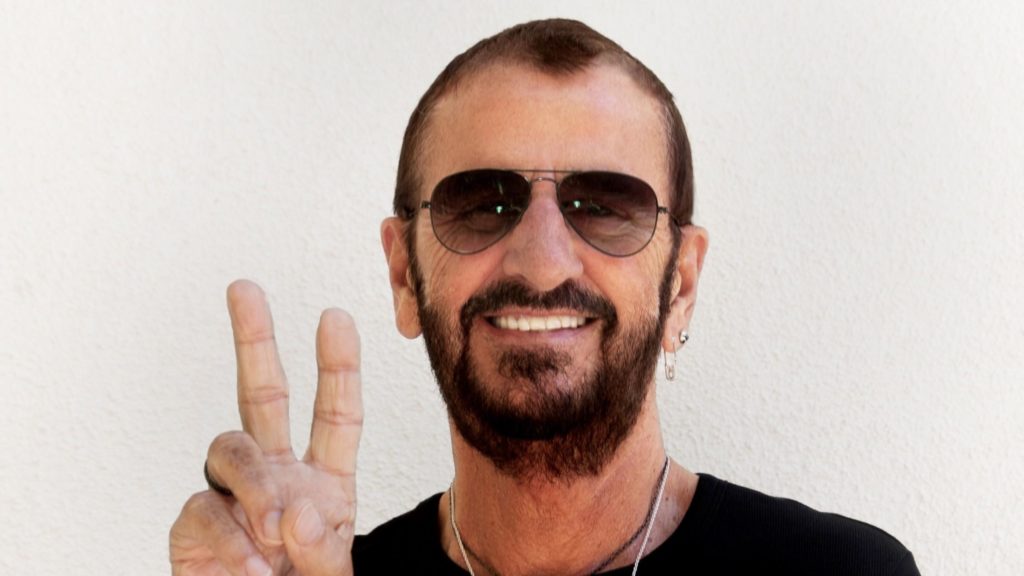RINGO STARR EMERGES FROM TROUBLED ERA WITH FIRST ALL-STARR BAND
Ringo Starr was in search of a reset, after devolving into alcoholism in the ’80s. He found it within the friendly confines of a group. Only this time, rather than the Beatles, it was an All-Starr Band.
“I was afraid at the beginning,” Starr told Rolling Stone in 2019. “[I thought,] ‘I don’t know how you do anything if you’re not drunk.’ That’s where I ended up: I couldn’t play sober, but I also couldn’t play as a drunk. So, when I did end up in rehab, it was like a light went on and said, ‘You’re a musician; you play good.'”
Still, at this point, Starr hadn’t put out an album since 1983’s Old Wave, and by then he’d already lost his recording contract. He hadn’t reached the Top 40 since 1976’s Ringo’s Rotogravure. Along the way, he’d lost his career, followed by his confidence.
Then David Fishof reached out. A one-time sports agent, Fishof had recently emerged as a tour producer with a hot hand. He imagined a series of guest-laden dates featuring Starr, in keeping with his recent successes with the Happy Together Tour and the Dirty Dancing trek.
“I wrote a letter, and a few months later I got a call to go over to England and meet with Ringo,” Fishof told the Jerusalem Post in 2018. “At that time, he was doing absolutely nothing – he and [wife] Barbara [Bach] had come out of rehab and were looking for something to do.”
Starr, who had never toured America before, warmed to the idea of surrounding himself with like-minded friends and favored colleagues. It certainly would take some of the pressure off, since this would be the first U.S. tour by any member of the Beatles since Paul McCartney’s Wings Over America jaunt in 1976.
The idea was to fill each role in a traditional band, while bolstering the rhythm section – since Starr would occasionally be out front with his own songs. Dr. John manned the piano, and Billy Preston was at the organ. Rick Danko and Levon Helm from the Band played bass and drums, respectively. Guitarist Nils Lofgren and saxophonist Clarence Clemons came over from the E Street Band. The lineup was rounded out by guitarist Joe Walsh and drummer Jim Keltner.
They immediately clicked. “The first three days of rehearsal were really fun and fabulous for us,” Starr told WKSG in 1989, “but then we realized that we had better stop jamming and find some order.”
As everything came together, Starr fell into his most familiar role: ace bandmate among a roster dotted with big names. Fishof’s concept also provided some needed depth and variety in song selection.

They opened the tour on July 23, 1989, at the Park Central Amphitheatre in Dallas. The set list was anchored by Starr songs and Starr-sung Beatles-era tracks including “It Don’t Come Easy,” “Yellow Submarine,” “Photograph” “Back Off Boogaloo” and, of course, “With a Little Help From My Friends.” Those titular friends took turns in between, offering rollicking versions of Dr. John’s “Right Place, Wrong Time,” Billy Preston’s “Will It Go Round in Circles,” the Band’s “Up on Cripple Creek,” Clarence Clemons’ “You’re a Friend of Mine” and Eagles’ “Life in the Fast Lane,” among others.
As the dates progressed, a group of strangers became close friends, as illustrated by a regular turn by Dr. John on the third verse of the Band’s “The Weight.” The shows seemed to be as effortless as they were contagiously fun. Starr’s comeback vision had come true.
“I knew I wanted a bunch of great musicians,” Starr told WKSG, “but I also didn’t want to be up in front all the time. I wanted to have fun on the drums, playing with other great artists. I wanted top-notch singing musicians.”
In truth, Starr was initially unsure about how to start. He wondered if anybody would do it. Then, he finally just started throwing out names. “Ringo said that he wanted Joe Walsh and Levon Helm,” Fishof told the Jerusalem Post. “I suggested Nils Lofgren and Clarence Clemons, and I contacted Billy Preston.”
Some had direct connections to Starr: Walsh had produced Old Wave. Preston had sat in on a series of Beatles sessions that produced 1969’s Abbey Road and 1970’s Let It Be.
“I said yes right away,” Preston told the Los Angeles Times in 1989. “It’s a thrill to see Ringo get the spotlight, be the up-front man. With the Beatles, he was always in the background.”

Their schedules just seemed to fall into place. The Band had reformed without Robbie Robertson, but hadn’t yet resumed recording. Lofgren and Clemons had only recently been informed that Bruce Springsteen planned to move forward without the E Street Band.
“I was shocked, I was hurt and then I was happy,” Clemons told the Orange County Register in 1989. “Life goes on, and it’s tremendously freeing. Before, I always had to look over my shoulder and, if I wanted to do something, I had to see what was happening with Bruce. Now, I can go on with my life.”
With so many famous folks, the worry early on was probably that egos would get in the way. But these guys not only clicked, they turned that concern into a prank that illustrated just how tightly knit they’d become.
“After the fourth show of that first tour,” Fishof told the Jerusalem Post, “I was eating dinner at the Garden State Arts Center in New Jersey and Clarence Clemons walks up to me and says, ‘I’m outta here. This idea of yours isn’t going to work. You can’t put all these stars in one band; they’re not going to get along.'”
He said Walsh and Helm were in the middle of huge fight. Playing along, Lofgren said he’d had enough too. “I rushed into the dressing room, and Joe and Levon are screaming at each other,” Fishof told the Post. “Joe’s got a knife and Levon’s got a broken, jagged bottle. Just when I was ready to run, they turned to me, put their arms around each other and stuck their tongues out. Ringo walked out from behind a corner, and everyone had a good laugh at my expense.”
Fishof went onto other projects, including the Rock and Roll Fantasy Camp, but Starr kept their original idea alive. He’s since led more than dozen All-Starr Band tours, with a revolving group of collaborators. Walsh became a regular presence over the years. Todd Rundgren has been part of several iterations, including a long-running ’10s-era lineup that also included Steve Lukather and Gregg Rolie.
“I got over the mad first, second year, and now, this is how I live,” Starr told Rolling Stone. “It’s a normal way of living now, and I have a lot of fun.”


